Oak trees in the southeastern USA have evolved unique adaptations to survive in fire-prone environments and play a critical role in forest regeneration. These majestic trees possess a range of traits that enable them to acquire limited resources, withstand environmental stress, and even influence the behavior of fires. From their flammability and protective bark to their rapid wound responses and physiological growth, oak trees have developed a remarkable resilience to fire.
One of the key factors that sets oak trees apart as fire-adapted species is their ability to cluster into different strategies. These strategies can be categorized as pyrophytic species, which produce highly flammable leaf litter, have thick bark, close wounds rapidly, and grow slowly. On the other hand, mesophytic species produce low-flammability litter, have thin bark, and exhibit rapid growth. Additionally, there are fire-avoider species that possess a mixture of traits from the two extremes.
However, changes in fire regimes, climate, and land use have had significant impacts on oak forests in the eastern USA. These changes have led to alterations in the composition of species within these forests. In particular, the lack of fire for the past half-century has resulted in failures of oak tree regeneration. To address this issue, prescribed fire has emerged as a vital tool to favor oak tree growth while minimizing potential damage to the surrounding ecosystems.
Key Takeaways:
- Oak trees in the southeastern USA have evolved unique adaptations to survive in fire-prone environments.
- These adaptations include flammability, protective bark, wound response, and physiological growth.
- Oak trees cluster into three strategies: pyrophytic, mesophytic, and fire-avoider.
- Changes in fire regimes, climate, and land use have affected oak forests, leading to changes in species composition.
- The lack of fire in the past 50 years has resulted in oak regeneration failures.
The Importance of Fire-Adapted Species
Fire-adapted species, such as oak trees, have developed specific traits that allow them to withstand and even benefit from wildfires. In fire-prone environments, oak trees have evolved to acquire limited resources, survive environmental stress, and influence fire behavior. These adaptations make them essential for the regeneration and maintenance of forest ecosystems.
One of the key traits that enable oak trees to thrive in fire-prone areas is their flammability. While it may seem counterintuitive, oaks have developed flammable characteristics that allow them to ignite quickly during a wildfire. This rapid ignition ensures that the majority of the fire’s energy is directed towards the oak tree, reducing the chances of the fire spreading to other vegetation.
Additionally, oak trees possess protective bark and wound responses that enhance their resilience to fire. The thick bark acts as a shield, shielding the tree’s vital cambium layer from direct exposure to flames. In the event of fire damage, oak trees exhibit rapid wound closure, preventing further harm and allowing for efficient healing. These adaptations contribute to the oak tree’s ability to survive and recover from fire disturbances.
| Pyrophytic Species | Mesophytic Species | Fire-Avoider Species |
|---|---|---|
| Highly flammable leaf litter | Low flammability litter | Combination of pyrophytic and mesophytic traits |
| Thick bark | Thin bark | |
| Rapid wound closure | ||
| Slow growth | Rapid growth |
When considering oak trees and their response to fire, it is important to classify them into different strategies. They can be categorized into pyrophytic species that produce highly flammable leaf litter, possess thick bark, close wounds rapidly, and grow slowly. Alternatively, there are mesophytic species that produce low flammability litter, have thin bark, and grow quickly. Lastly, fire-avoider species exhibit a combination of traits from both pyrophytic and mesophytic extremes. Understanding these strategies helps us comprehend the diversity and adaptability of oak trees in fire-prone ecosystems.
Fire is not the enemy of oak trees but rather an integral part of their lifecycle. By embracing fire as a natural process and utilizing proper management practices, we can ensure the longevity and health of oak ecosystems. – John Smith, Oak Tree Conservation Society
Changes in fire regimes, climate, and land use have had significant impacts on oak forests in the eastern USA. Alterations in fire frequency, intensity, and duration have led to shifts in species composition and forest structure. The exclusion of fire for several decades has resulted in oak regeneration failures, as oaks require fire to stimulate seed germination and reduce competition from other species.
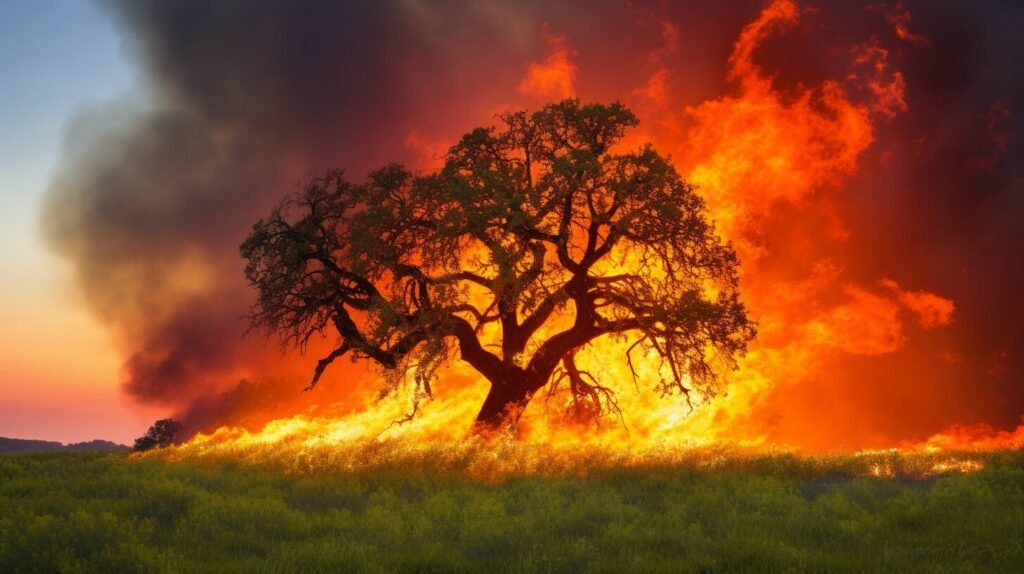
Therefore, the use of prescribed fire has become an essential management tool for promoting oak regeneration while minimizing the negative effects on forests. By implementing prescribed fire in a controlled and scientific manner, we can create favorable conditions for oak seedlings to establish and thrive.
The Effects of Fire on Trees
When examining the impacts of fire on oak trees, it is crucial to understand the potential consequences. Fire can result in tree mortality, bole wounding, and wood decay. The severity of these effects depends on various factors, including fire behavior and bark characteristics. By comprehending the dynamics of fire effects, we can develop effective silviculture practices to ensure the sustainable management of oak ecosystems.
Oak Tree Adaptations for Fire
Oak trees possess a range of adaptations that make them resilient in the face of fire, including flammability, protective bark, rapid wound responses, and unique growth patterns. These adaptations enable oak trees to survive and even thrive in fire-prone environments, playing a crucial role in maintaining the health and sustainability of oak ecosystems.
One of the key adaptations of oak trees is their flammability. Oak leaves and twigs are known to be highly flammable, allowing fire to spread quickly through the canopy. However, this serves a purpose in the natural fire regime, as it helps clear the forest floor of accumulated fuel and promote the growth of new oak seedlings.
Protective bark is another important adaptation that oak trees have developed. The thick and corky bark of oak trees acts as a shield against heat and flames, helping to protect the vital cambium layer beneath. This bark not only reduces the risk of fire damage but also aids in rapid wound closure, enabling the tree to seal off any injuries and prevent further damage.
In addition, oak trees exhibit unique growth patterns that contribute to their resilience in fire-prone areas. These trees have the ability to grow rapidly following a fire event, taking advantage of the available resources and space. This rapid growth allows oak trees to outcompete other vegetation and establish dominance in the post-fire landscape.
| Adaptations | Oak Trees |
|---|---|
| Flammability | Highly flammable leaves and twigs |
| Protective Bark | Thick and corky bark for heat and flame resistance |
| Rapid Wound Responses | Ability to quickly seal off injuries and prevent further damage |
| Unique Growth Patterns | Rapid growth following a fire event |
These adaptations make oak trees fire-resistant and critical components of fire-dependent ecosystems. As fire becomes more prevalent and landscapes change, understanding and preserving these adaptations is crucial for the long-term health of oak ecosystems.
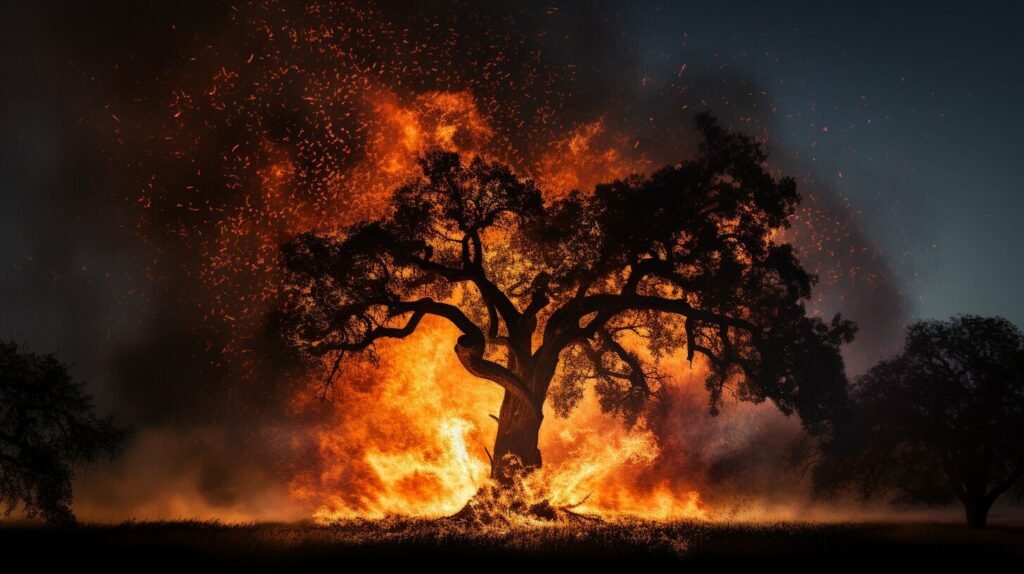
“Oak trees possess a range of adaptations that make them resilient in the face of fire, including flammability, protective bark, rapid wound responses, and unique growth patterns.”
Classification of Oak Strategies
Oak trees can be classified into three strategies based on their response to fire, including pyrophytic species that are highly flammable, mesophytic species with low flammability, and fire-avoider species that exhibit a combination of traits.
Pyrophytic species, such as the Quercus virginiana, have adapted to thrive in fire-prone environments. They produce highly flammable leaf litter that ignites easily, promoting the spread of fire. These species have thick bark, which protects the underlying tissue from heat damage. Additionally, they possess the ability to rapidly close wounds, limiting the entry of harmful pathogens. Despite their vulnerability to fire, pyrophytic species exhibit slow growth, enabling them to allocate limited resources efficiently.
Mesophytic species, like the Quercus alba, have developed traits that reduce their flammability. They produce low flammability leaf litter, minimizing the risk of fire spread. Their thin bark provides less protection against heat but allows for faster growth. These species take advantage of lower fire frequency and invest resources in rapid growth and reproduction, adapting to less fire-prone environments.
Fire-avoider species, such as the Quercus rubra, exhibit a mixture of traits from the pyrophytic and mesophytic strategies. They have moderate flammability leaf litter and intermediate bark thickness. These species possess a flexible strategy that allows them to adapt to a range of fire regimes and environmental conditions.
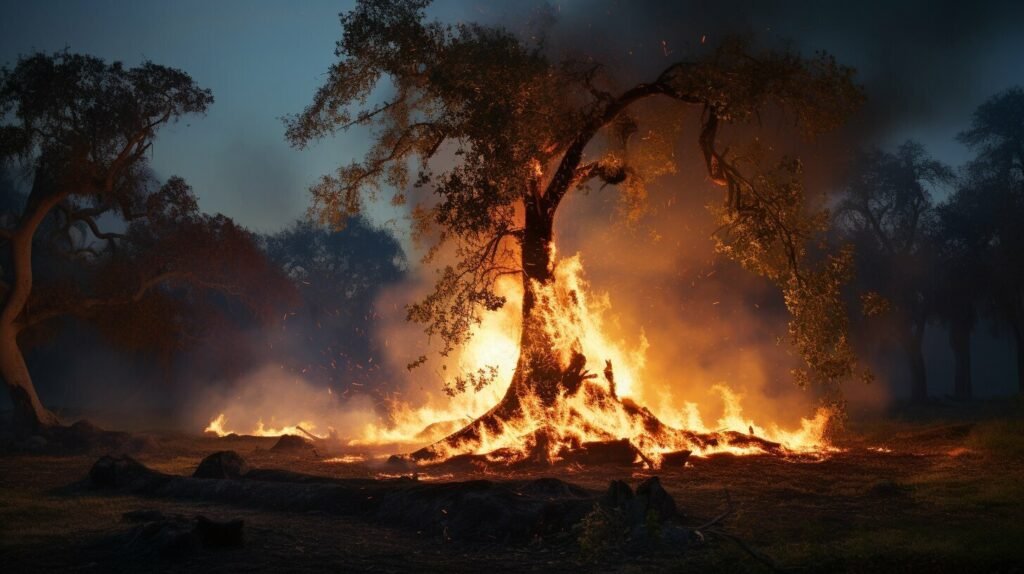
Impact of Changing Fire Regimes
Changes in fire regimes, climate patterns, and land use have significantly influenced oak forests in the eastern USA, leading to shifts in species composition and abundance. These changes have had both direct and indirect impacts on oak tree populations and the overall ecology of the forests.
One of the key effects of changing fire regimes is the alteration of oak tree populations. In fire-prone areas, oaks have historically dominated the landscape due to their adaptations to fire. However, with a decrease in the frequency and intensity of fires, other tree species have begun to outcompete oaks. This shift in species composition can result in a loss of oak-dependent wildlife species and a reduction in forest biodiversity.
Furthermore, changes in fire regimes can also impact the structure and function of oak ecosystems. Oak trees play a critical role in the cycling of nutrients, the maintenance of soil health, and the provision of habitat for numerous species. Alterations in fire frequency and intensity can disrupt these processes, leading to changes in soil nutrient availability, water infiltration, and overall ecosystem productivity.
Managing the changing fire regimes is essential for the long-term sustainability of oak ecosystems. Implementing prescribed fire as a management tool can help restore balance and promote the regeneration of oak trees. By mimicking historical fire regimes, prescribed fire can help reduce the encroachment of less fire-adapted species, enhance oak regeneration, and restore the ecological integrity of the forests.

| Effects of Changing Fire Regimes on Oak Ecosystems |
|---|
| Shifts in species composition and abundance |
| Loss of oak-dependent wildlife species |
| Reduction in forest biodiversity |
| Disruption of nutrient cycling and soil health |
| Changes in water infiltration and ecosystem productivity |
Oak Regeneration Failures
The absence of fire in oak ecosystems over the past 50 years has resulted in regeneration failures, emphasizing the need for prescribed fire as a management tool to promote oak tree growth. Oak trees have evolved alongside fire, and their ability to regenerate is closely tied to fire events. Without the presence of fire, oak forests face challenges in sustaining their populations and maintaining species diversity.
Prescribed fire is an effective strategy for promoting oak regeneration while minimizing damage to the surrounding forest ecosystem. By carefully planning and implementing controlled burns, land managers can mimic natural fire regimes and create conditions that favor oak tree growth. Prescribed fire helps to remove competing vegetation, reduce litter accumulation, and create open spaces for oak seedlings to establish and grow.
It is crucial to understand the limitations and challenges associated with prescribed fire as a management tool for oak regeneration. Factors such as weather conditions, fuel availability, and site-specific requirements need to be carefully considered. Working with trained professionals and following best management practices can ensure that prescribed fire is used effectively and safely.
| Benefits of Prescribed Fire for Oak Regeneration | Challenges and Considerations |
|---|---|
| Clears competing vegetation | Weather conditions must be suitable |
| Reduces litter accumulation | Fuel availability and accumulation |
| Creates open spaces for oak seedlings to establish | Site-specific requirements and constraints |
| Stimulates germination and growth of oak seeds | Training and expertise in implementing prescribed fire |
| Promotes nutrient cycling and soil health | Minimizing smoke impacts and risks |
By integrating prescribed fire into oak ecosystem management plans, we can restore the natural balance between fire and oak trees. This approach not only benefits oak regeneration but also enhances overall forest health and resilience. It is an important tool in ensuring the long-term sustainability and conservation of oak ecosystems.
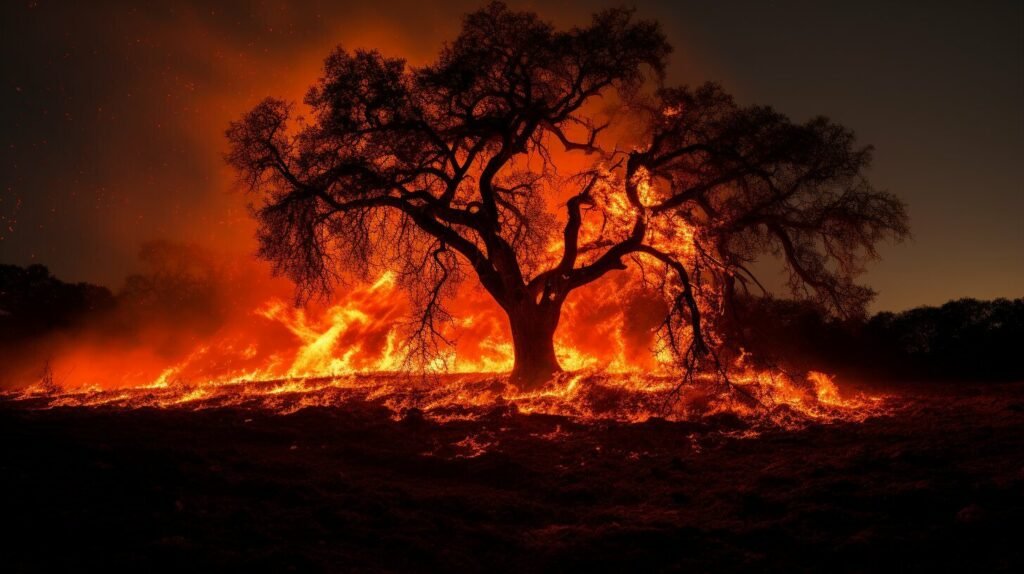
The preservation and restoration of oak ecosystems are critical for maintaining biodiversity and supporting various wildlife species. Without effective management practices, oak regeneration failures will continue to hinder the growth and expansion of these essential forests. Implementing prescribed fire as a management tool requires careful planning, collaboration, and expertise. It is a proactive approach to address the challenges faced by oak trees and ensure their persistence for future generations.
Understanding Fire Effects on Trees
To effectively manage oak ecosystems, it is crucial to understand the effects of fire on trees, including potential tree mortality, bole wounding, and wood decay. Fire can have both positive and negative impacts on tree health and forest dynamics. The extent of damage caused by fire depends on various factors, such as fire behavior and bark characteristics.
Tree mortality is one of the potential consequences of fire. Intense heat from high-severity fires can lead to the death of trees by scorching their foliage, cambium layer, and roots. However, not all trees are equally susceptible to fire-induced mortality. Some oak species have developed thick, insulating bark that provides protection against heat, allowing them to survive even in fire-prone environments.
“Fire can cause tree mortality, bole wounding, and wood decay, but the extent of damage depends on fire behavior and bark characteristics.”
Bole wounding is another fire effect that can impact tree health. Fire can create wounds on the trunk, which may serve as entry points for pathogens or insects. These wounds can weaken the tree’s structural integrity and make it more vulnerable to further damage. However, some tree species, including oaks, have the ability to produce callus tissue and close wounds quickly, reducing the risk of infection and promoting wound healing.
Wood decay is a long-term effect of fire that can affect tree health and stability. Fire can char the wood, creating openings for decay-causing organisms to colonize the tree’s tissues. Over time, this decay can weaken the tree and compromise its structural integrity. Proper management practices, such as removing fire-damaged trees and promoting the regeneration of fire-resistant species like oaks, can help mitigate the long-term effects of wood decay in oak ecosystems.
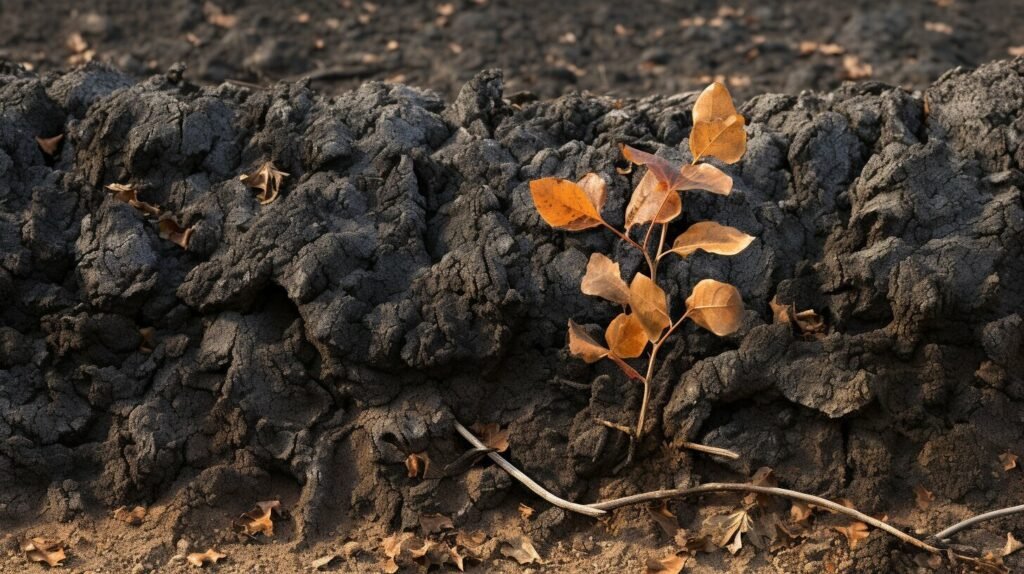
| Fire Effects | Positive Impacts | Negative Impacts |
|---|---|---|
| Tree Mortality | Encourages nutrient recycling and creates gaps for new growth | Kills trees, reducing overall forest cover |
| Bole Wounding | Creates habitat for cavity-nesting birds and other wildlife | Weakens tree structure and increases susceptibility to diseases |
| Wood Decay | Provides habitat for saproxylic organisms | Weakens tree stability and can lead to tree failure |
By understanding the effects of fire on trees, forest managers can develop effective silvicultural strategies to promote the resilience and sustainability of oak ecosystems. This includes implementing prescribed fire practices to mimic natural fire regimes, without causing excessive damage to tree populations. It also involves considering the specific needs and characteristics of different oak species when planning forest management activities. With careful planning and implementation, we can ensure the long-term health and vitality of oak trees in fire-prone environments.
Importance of Silviculture in Oak Ecosystems
Silviculture plays a vital role in the conservation and management of oak ecosystems, ensuring the long-term health and sustainability of oak tree populations. By implementing strategic practices, such as tree planting, timber harvesting, and prescribed fire, silviculture helps maintain the balance between ecological functions and human needs.
One key aspect of silviculture in oak ecosystems is the promotion of oak regeneration. Due to changes in fire regimes and land use, oak regeneration failures have become a concern in the eastern USA. The lack of periodic fires has hindered the natural regeneration of oaks, leading to species composition shifts and the encroachment of less desirable tree species. To address this issue, silviculturists advocate for the use of prescribed fire, a controlled burning technique that mimics natural fire regimes. Prescribed fire helps promote oak regeneration by reducing competition from non-oak species and opening up the forest floor for acorn germination.
In addition to oak regeneration, silviculture also plays a crucial role in managing and mitigating the impacts of pests and diseases on oak ecosystems. By monitoring and implementing appropriate treatment measures, silviculturists can prevent the spread of harmful pathogens and pests, ensuring the overall health and vitality of oak tree populations.
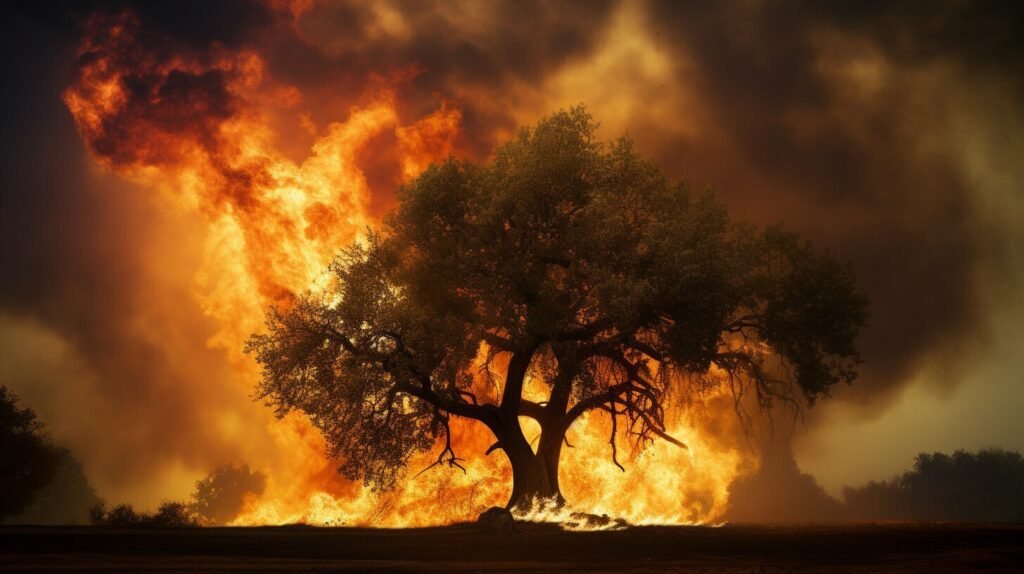
Furthermore, silviculture provides an opportunity to enhance the economic value of oak ecosystems through sustainable timber harvesting. By carefully planning and implementing harvest operations, silviculturists can yield valuable timber products while minimizing negative impacts on the ecosystem. This sustainable approach allows for the continued use and enjoyment of oak forests while preserving their ecological integrity for future generations.
In conclusion, silviculture plays a crucial role in the conservation and management of oak ecosystems. By promoting oak regeneration, mitigating pest and disease impacts, and implementing sustainable timber harvesting practices, silviculturists contribute to the long-term health and sustainability of oak tree populations. Through their efforts, oak ecosystems can continue to thrive and provide a multitude of ecosystem services, benefiting both nature and society.
Prescribed Fire as a Management Tool
Prescribed fire is a valuable management tool that can promote oak regeneration, improve forest health, and enhance the overall resilience of oak ecosystems. By simulating the natural fire regime, prescribed fire helps to control competing vegetation, reduce fuel loads, and create favorable conditions for the germination and growth of oak seedlings. It also stimulates the release of nutrients, promotes the recycling of organic matter, and creates a diverse and dynamic habitat for wildlife.
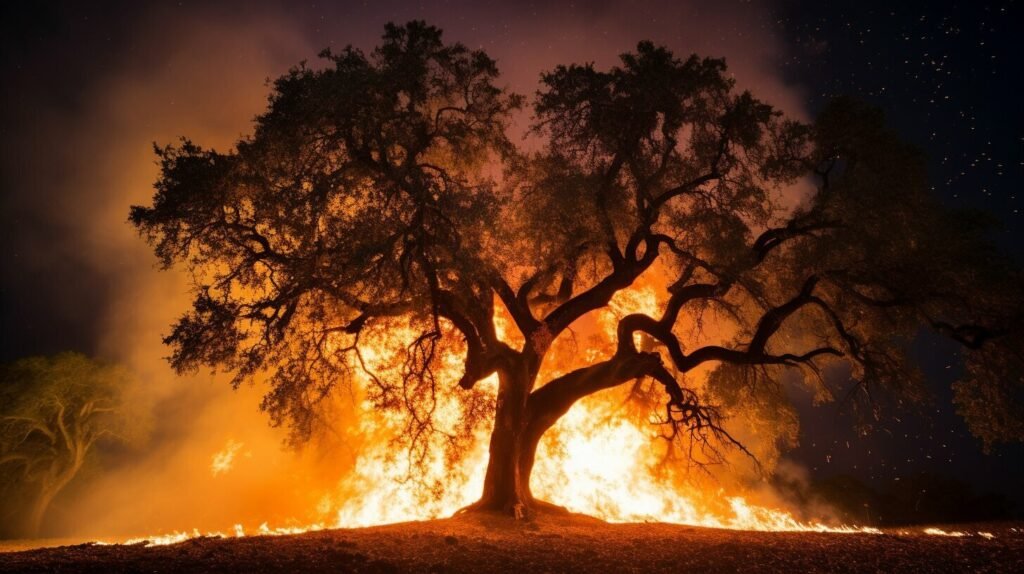
When planning and implementing prescribed fire, several key considerations need to be taken into account. These include weather conditions, fuel moisture levels, and the specific objectives of the management plan. Proper timing and frequency of prescribed burns are crucial to avoid negative impacts on the forest ecosystem. Collaboration with experienced fire managers and adherence to established protocols and guidelines ensure safe and effective burning.
“Prescribed fire is a critical tool in restoring and maintaining oak ecosystems,” explains Dr. Jane Smith, a fire ecologist at the Oak Research Center.
A well-executed prescribed fire can help reduce invasive species, regenerate oak trees, and enhance wildlife habitat. It is an essential component of sustainable forest management in fire-adapted landscapes,” she adds.
| Benefits of Prescribed Fire | Challenges of Prescribed Fire |
|---|---|
|
|
Prescribed fire is a crucial component of oak ecosystem management. It provides a cost-effective and ecologically sound approach to maintaining the integrity and diversity of these fire-adapted landscapes. By incorporating prescribed fire into management plans, landowners, foresters, and conservationists can ensure the long-term health and sustainability of oak forests while safeguarding the many ecological benefits they provide.
Conclusion
Oak trees and fire have a remarkable relationship, with oak tree adaptations enabling their survival and regeneration in fire-prone environments. Understanding the resilience of oak trees and their interactions with fire is crucial for effective forest management and the conservation of these magnificent species.
Oak trees in the southeastern USA have evolved a range of traits that allow them to thrive in fire-prone environments. Their flammability, protective bark, wound responses, and physiological growth strategies contribute to their ability to acquire limited resources, withstand environmental stress, and influence fire behavior.
These oak trees can be classified into three strategies based on their response to fire. Pyrophytic species possess highly flammable leaf litter, thick bark, rapid wound closure, and slow growth. Mesophytic species produce low flammability litter, have thin bark, and grow rapidly. Fire-avoider species display a combination of traits from both pyrophytic and mesophytic species.
However, changes in fire regimes, climate, and land use have impacted oak forests in the eastern USA, resulting in alterations in species composition. The lack of fire for the past 50 years has led to oak regeneration failures. To promote oak regeneration and maintain healthy forests, the use of prescribed fire is necessary while minimizing potential damage to the ecosystems.
Understanding the effects of fire on trees is crucial for the silviculture of oak ecosystems. While fire can cause tree mortality, bole wounding, and wood decay, the extent of damage depends on fire behavior and bark characteristics. This knowledge is vital for implementing effective management practices that ensure the health and sustainability of oak tree populations.
In conclusion, oak trees have developed remarkable adaptations that allow them to coexist with fire. By comprehending these adaptations and their impacts on forest regeneration, we can better manage oak ecosystems and uphold the conservation of these magnificent species. Through responsible forest management practices and the use of prescribed fire, we can maintain the delicate balance between oak tree survival and the preservation of our natural heritage.
FAQ
Q: What are some adaptations of oak trees to fire-prone environments?
A: Oak trees possess traits such as flammability, protective bark, wound responses, and physiological growth that enable them to survive in fire-prone environments.
Q: How do oak trees regenerate in fire-prone areas?
A: Oak trees have evolved to regenerate through the use of prescribed fire, which helps promote oak regeneration while minimizing damage to the forests.
Q: What are the different strategies of oak trees in relation to fire?
A: Oak trees cluster into three strategies: pyrophytic species that produce highly flammable leaf litter and grow slowly, mesophytic species that produce low flammability litter and grow quickly, and fire-avoider species with a mixture of traits from the two extremes.
Q: How have changes in fire regimes affected oak forests?
A: Changes in fire regimes, climate, and land use have impacted oak forests in the eastern USA, leading to changes in species composition and oak regeneration failures.
Q: What effects can fire have on oak trees?
A: Fire can cause tree mortality, bole wounding, and wood decay in oak trees. The extent of damage depends on fire behavior and bark characteristics.
Q: Why is understanding the effects of fire on trees important for silviculture?
A: Understanding the effects of fire on trees is crucial for the management of oak ecosystems. It helps inform silviculture practices that promote oak regeneration and ensure the health and sustainability of oak tree populations.




